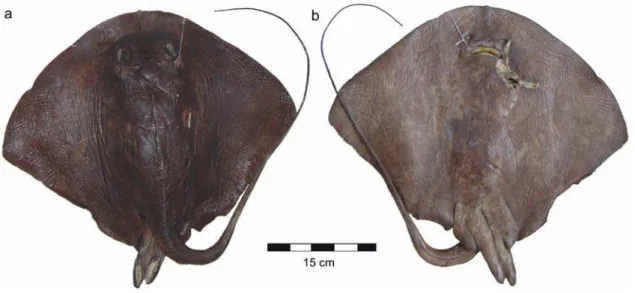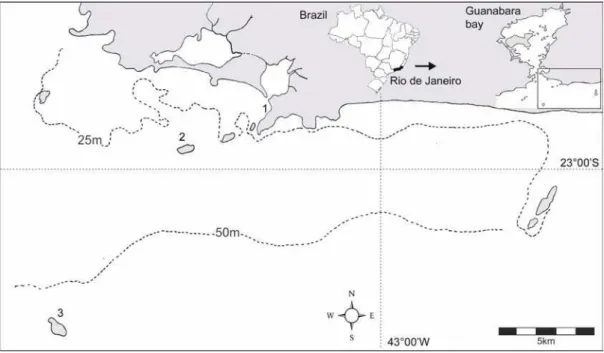NOTE
BRAZILIAN JOURNAL OF OCEANOGRAPHY, 55(4):323-325, 2007
DATA ON THE PELAGIC STINGRAY, PTEROPLATYTRYGON VIOLACEA
(BONAPARTE, 1832) (MYLIOBATIFORMES: DASYATIDAE)
CAUGHT IN THE RIO DE JANEIRO COAST
Andréa Espinola de Siqueira1 and Vivianne Bernardo de Sant’Anna2
1
Universidade do Estado do Rio de Janeiro, Instituto de Biologia - Departamento de Zoologia (Rua São Francisco Xavier, 524, 20559-900 Rio de Janeiro, RJ, Brasil)
deiaespinola@hotmail.com
2
Pontifícia Universidade Católica, Museu de Ciências e Tecnologia - Laboratório de Ictiologia (Av. Ipiranga, 6681, CP. 1429, 90619-900 Porto Alegre, RS, Brasil)
zapteryx@yahoo.com
Descriptors:Pteroplatytrygon violacea, Distribution, Reproduction, Brazil.
Descritores:Pteroplatytrygon violacea, Distribuição, Reprodução, Brasil.
The pelagic stingray, Pteroplatytrygon violacea is a thick, dark stingray, with a broadly rounded snout and a trapezoidal disc. This species is easily recognized by its conspicuos pygmentary pattern, displaying a uniform dark-purple on dorsal body surface and light-violet on its ventral surface. The eyes are small and do not protrude from the body as in several other stingrays (Fig. 1) (BIGELOW; SCHROEDER, 1953). This taxon has a circumtropical and subtropical distribution, being caught at depths from 37 to 1463 m. It is the only oceanic-pelagic
member of the family Dasyatidae currently known (WILSON; BECKETT, 1970; MENNI; STEHMANN, 2000; MOLLET, 2002).
Despite the fact that this species has no comercial value, some captures in longliners for swordfish and tuna as by-catch are reported worldwide (e.g. São Paulo/Brazil - AMORIM et al., 1998; California/USA - MOLLET, 2002; Uruguay - DOMINGO et al., 2005; Taiwan - JOUNG et al., 2005; Atlantic ocean – WILSON; BECKETT, 1970).
The species reproductive behavior has been poorly understood. Only recently, with the increasing of captivity studies, its reproductive and feeding habits are beginning to be known (MOLLET et al., 2002). This study intends to contribute to the knowledge of the species, focusing on three main points: (1) comments on some biological aspects of landed specimens of P. violacea, (2) providing the first published record of this species in Brazilian shallow waters (maximum depth 50 m) and (3) to discuss which parameters can influence its seasonal distribution on the Rio de Janeiro coast.
Specimens and data were obtained from the artisanal fishery landings at Itaipu Beach, Niterói, RJ (22o58’S and 43o03’W, Fig. 2), Southeastern Brazil. The landings were monitored weekly from October 1999 to December 2001. P. violacea specimens were caught by handline fishery operating at depths from 30 to 45 m. This fishery is concentrated in adjacent areas of “Ilha do Pai” (22o59’S and 43o05’W) and “Ilha Rasa” (23o04’S and 43o08’W). After landing, specimens were identified, measured (disc width DW - in mm), weighted (total weight TW – in g), sexed, stage of sexual development determined and dissected to remove stomach content.
Eight specimens were examined, measuring between 480 and 655 mm (mean = 538 +47 mm DW) and weighing between 3000g and 8500g (TW). The
specimens were caught only in January and February, 2000 and 2001. Few landings of this species were known in the local fishery and due to the low economic value, this ray is often discarded by fishermen. This pattern of temporal distribution was not observed in other elasmobranchs in Itaipu Beach.
The interviews with fishers suggest that P. violacea follows schools of the species Trichiurus lepturus (Linnaeus, 1758), both species approaching the coast hunting schools of small fishes. The analysis of four stomach contents (two females and two males) revealed two empty stomachs, while the other two contained teleost remains not identified (vertebrae fragments and crystallines). In oceanic-pelagic areas of southern Brazil the diet of the species includes a variety of food items, like amphipods, decapods and teleostean fish (AMORIM et al., 1998; MAZZOLENI; SCHWINGEL, 2002).
All specimens herein examined were mature, five of them females and three males. The females had flaccid uterus, two of them aborted the litter on board, and fishers set them free. In the offshore region of southern Brazil, pregnant females were caught between January and February; females carried mid-term and near-mid-term embryos (AMORIN et al., 1998; MAZZOLENI; SCHWINGEL, 2002). In both extremes of P. violacea distribution in the western South Atlantic (Northeast Brazil and southern Uruguay), there are no records of pregnant females aborting on board (MENNI et al., 1995).
The distribution of P. violacea througout the Brazilian offshore shows that this species is related to oceanic islands being considered an epipelagic species (MAZZOLENI; SCHWINGEL, 2002; VASKE JR et al., 2005). Unlike other areas, in Itaipu Beach, P. violacea is caught in coastal waters, in dephts shallower than 45 m, and seems to be related with cold waters, below 18°C.
In summer and late spring, Rio de Janeiro coastal waters suffer influences of changings in water mass, like the coastal upwelling observed more intensely from Arraial do Cabo to Ilha Grande. During this phenomenon, the cold water mass deriving from deep oceanic regions (SACW - South Atlantic Central Water mass) penetrates into the bottom layer over the continental shelf (MATSUURA, 1986). This phenomenon affects the distribution of several teleosteans and, at least, four species of elasmobranchs (Squatina spp. Psammobatis bergi and some rajids), that show a trend to migrate from 50-70 m depth to shallow waters between 25-45 m depth, following the cold currents full of nutrients (FAGUNDES NETTO ; GAELZER, 1991).
We assume that this changing in the marine current also changes the diversity of the marine species of Itaipu Beach, bringing oceanic species to coastal waters. Pteroplatytrygon violacea as an epipelagic species inhabits deep waters like those from SACW, so our data suggest that the species has an accidental occurrence in coastal waters, here exemplified by its occurrence on Itaipu Beach,being deviated from oceanic waters by changes in the water mass. While further studies do not focus the space and temporal variation of other groups, such as the teleosts, the extension of the upwelling influence on other localities of the Southeastern region beyond Arraial do Cabo, will not be understood.
A
CKNOWLEDGMENTSThe authors wish to thank Maria Eduarda Castro Leal for reviewing the English version of the manuscript, Henry F. Mollet, Rodrigo Mazzoleni and Teodoro Vaske Jr. for references and information. We especially thank the people and the fishers at Itaipu Beach, for their collaboration and friendship during the field work. This study was partially funded by CNPq (Conselho Nacional de Desenvolvimento Científico e Tecnológico) – Doctoral Degree Fellowship to senior author, and CAPES (Coordenação de Aperfeiçoamento de Pessoal de Nível Superior) – Masters Degree Fellowship to V. B. Sant’Anna.
R
EFERENCESAMORIM, A. F.; ARFELLI, C. A.; FAGUNDES, L. Pelagic elasmobranchs caught by longliners off southern Brazil during 1974-97: an overview. Mar. Freshwat.. Res., v. 49, p. 621-632, 1998.
BIGELOW, H. B.; SCHROEDER, W. C. Fishes of the Western North Atlantic. Part 2: Sawfishes, Guitarfishes, Sharks and Rays. New Haven: Sears Foundation for Marine Research, Yale University, 1953. Number I. 588 p.
DOMINGO, A.; MENNI, R. C.;; FORSELLEDO, R. Bycatch of the pelagic ray Dasyatis violacea in Uruguayan longline fisheries and aspects of distribution in the southwestern Atlantic. Sci. Mar., v. 69, n. 1, 161-166, 2005.
FAGUNDES NETTO, E. B.; GAELZER, L. R. Associações de peixes bentônicos e demersais na região do Cabo Frio, RJ, Brasil. Nerítica, Curitiba, v. 6, n. 1-2, p. 139-156, 1991.
JOUNG, S. J.; LIU, K. A. M.; LIAO, Y. Y. AND HSU, H. H... Observed by-catch of Taiwanese tuna longline fishery in the South Atlantic Ocean. J. Fish. Soc. Taiwan, v. 32, v. 1, p. 66-79, 2005
MATSUURA, Y. Contribuição ao estudo da estrutura oceanográfica da região sudeste entre Cabo Frio (RJ) e Cabo de Santa Marta Grande (SC). Ciência Cult., S Paulo, v. 38, n. 8, p. 1439-1450, 1986.
MAZZOLENI, R. C.; SCHWINGEL, P. R.. Aspectos da biologia das espécies capturadas por espinhel pelágico na região sul das Ilhas de Trindade e Martin Vaz no verão de 2001. Notas Tec. Facimar, v. 6, p. 51-57, 2002 MENNI, R. C.; STEHMANN, M. F. W. Distribution,
environment and biology of batoid fishes off Argentina, Uruguay and Brazil. A review. Rev. Mus. arg. Cienc. Nat., n.s., v. 2, n. 1, p. 69-109, 2000.
MENNI, R. C.; HAZIN, F. V.; LESSA, R. T. Ocurrence of the night shark Carcharhinus signatus and the pelagic stingray Dasyatis violacea off northeastern Brazil. Neotropica,v. 41, n. 105-106, p. 105-110, 1995. MOLLET, H. F. Distribution of the pelagic stingray,
Dasyatis violacea (Bonaparte, 1832), off California, Central America, and worldwide. Mar. Freshwat. Res.,, v. 53, p. 525-530, 2002.
MOLLET, H. F.; EZCURRA, J. M; O’SULLIVAN, J. B. Captive biology of the pelagic stingray, Dasyatis violacea (Bonaparte, 1832). Mar. Freshwat. Res., v. 53, p. 531–541, 2002.
VASKE JR, T.; LESSA, R. P.; DE NÓBREGA, M.; MONTEALEGRE-QUIJANO, S.; MARCANTE SANTANA, F.; BEZERRA JR., J. L. A Checklist of fishes from Saint Peter and Saint Paul Archipelago, Brazil. J. appl.. Ichthyol., v. 21, p. 75-79, 2005. WILSON, P. C.; BECKETT, J. S.. Atlantic ocean
distribuition of the pelagic Stingray, Dasyatis violacea. Copeia, v. 4, 696-707, 1970.
(Manuscript received 06 June 2006; revised 15 April 2007; accepted 18 March 2007)

